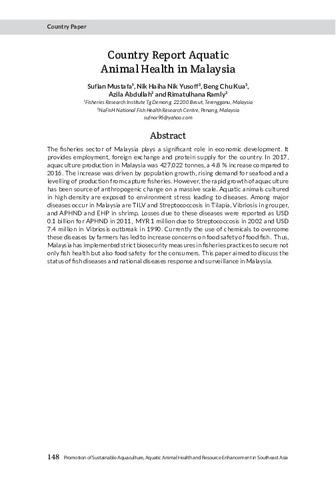Perlihatkan publikasi sederhana
Country report aquatic animal health in Malaysia
| dc.contributor.author | Mustafa, Sufian | |
| dc.contributor.author | Yusoff, Nik Haiha Nik | |
| dc.contributor.author | Kua, Beng Chu | |
| dc.contributor.author | Abdullah, Azila | |
| dc.contributor.author | Ramly, Rimatulhana | |
| dc.contributor.editor | Aya, Frolan A. | |
| dc.contributor.editor | de la Peña, Leobert D. | |
| dc.contributor.editor | Salayo, Nerissa D. | |
| dc.contributor.editor | Tendencia, Eleonor A. | |
| dc.date.accessioned | 2021-12-16T02:36:06Z | |
| dc.date.available | 2021-12-16T02:36:06Z | |
| dc.date.issued | 2021-12 | |
| dc.identifier.citation | Mustafa, S., Yusoff, N. H. N., Kua, B. C., Abdullah, A., & Ramly, R. (2021). Country report aquatic animal health in Malaysia. In F. A. Aya, L. D. de la Peña, N. D. Salayo, & E. A. Tendencia (Eds.), Proceedings of the International Workshop on the Promotion of Sustainable Aquaculture, Aquatic Animal Health, and Resource Enhancement in Southeast Asia (p. 148). Tigbauan, Iloilo, Philippines: Aquaculture Department, Southeast Asian Fisheries Development Center. | en |
| dc.identifier.isbn | 9789719931102 (Print) | |
| dc.identifier.isbn | 9789719931119 (PDF) | |
| dc.identifier.uri | http://hdl.handle.net/10862/6267 | |
| dc.description | Abstract only. | en |
| dc.description.abstract | The fisheries sector of Malaysia plays a significant role in economic development. It provides employment, foreign exchange and protein supply for the country. In 2017, aquaculture production in Malaysia was 427,022 tonnes, a 4.8 % increase compared to 2016. The increase was driven by population growth, rising demand for seafood and a levelling of production from capture fisheries. However, the rapid growth of aquaculture has been source of anthropogenic change on a massive scale. Aquatic animals cultured in high density are exposed to environment stress leading to diseases. Among major diseases occur in Malaysia are TILV and Streptococcosis in Tilapia, Vibriosis in grouper, and APHND and EHP in shrimp. Losses due to these diseases were reported as USD 0.1 billion for APHND in 2011, MYR 1 million due to Streptococcosis in 2002 and USD 7.4 million in Vibriosis outbreak in 1990. Currently the use of chemicals to overcome these diseases by farmers has led to increase concerns on food safety of food fish. Thus, Malaysia has implemented strict biosecurity measures in fisheries practices to secure not only fish health but also food safety for the consumers. This paper aimed to discuss the status of fish diseases and national diseases response and surveillance in Malaysia. | en |
| dc.language.iso | en | en |
| dc.publisher | Aquaculture Department, Southeast Asian Fisheries Development Center | en |
| dc.rights | Attribution-NonCommercial-ShareAlike 3.0 IGO | * |
| dc.rights.uri | http://creativecommons.org/licenses/by-nc-sa/3.0/igo/ | * |
| dc.subject | Malaysia | en |
| dc.subject | aquaculture production | en |
| dc.title | Country report aquatic animal health in Malaysia | en |
| dc.type | Conference paper | en |
| dc.citation.spage | 148 | |
| dc.citation.conferenceTitle | Proceedings of the International Workshop on the Promotion of Sustainable Aquaculture, Aquatic Animal Health, and Resource Enhancement in Southeast Asia | en |
| dc.subject.asfa | health | en |
| dc.subject.asfa | aquatic organisms | en |
| dc.subject.asfa | fishery economics | en |
| dc.subject.asfa | fish diseases | en |
| dc.subject.asfa | diseases | en |
Files in this item
Publikasi ini ada di koleksi berikut
-
Promotion of Sustainable Aquaculture, Aquatic Animal Health, and Resource Enhancement in Southeast Asia (SARSEA) [31]
Proceedings of the International Workshop on the Promotion of Sustainable Aquaculture, Aquatic Animal Health, and Resource Enhancement in Southeast Asia 25–27 June 2019, Iloilo City, Philippines



